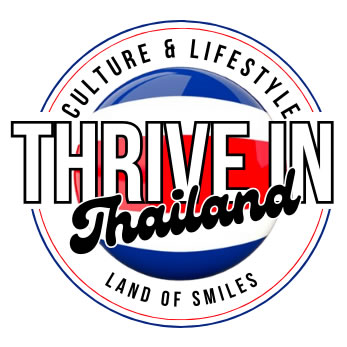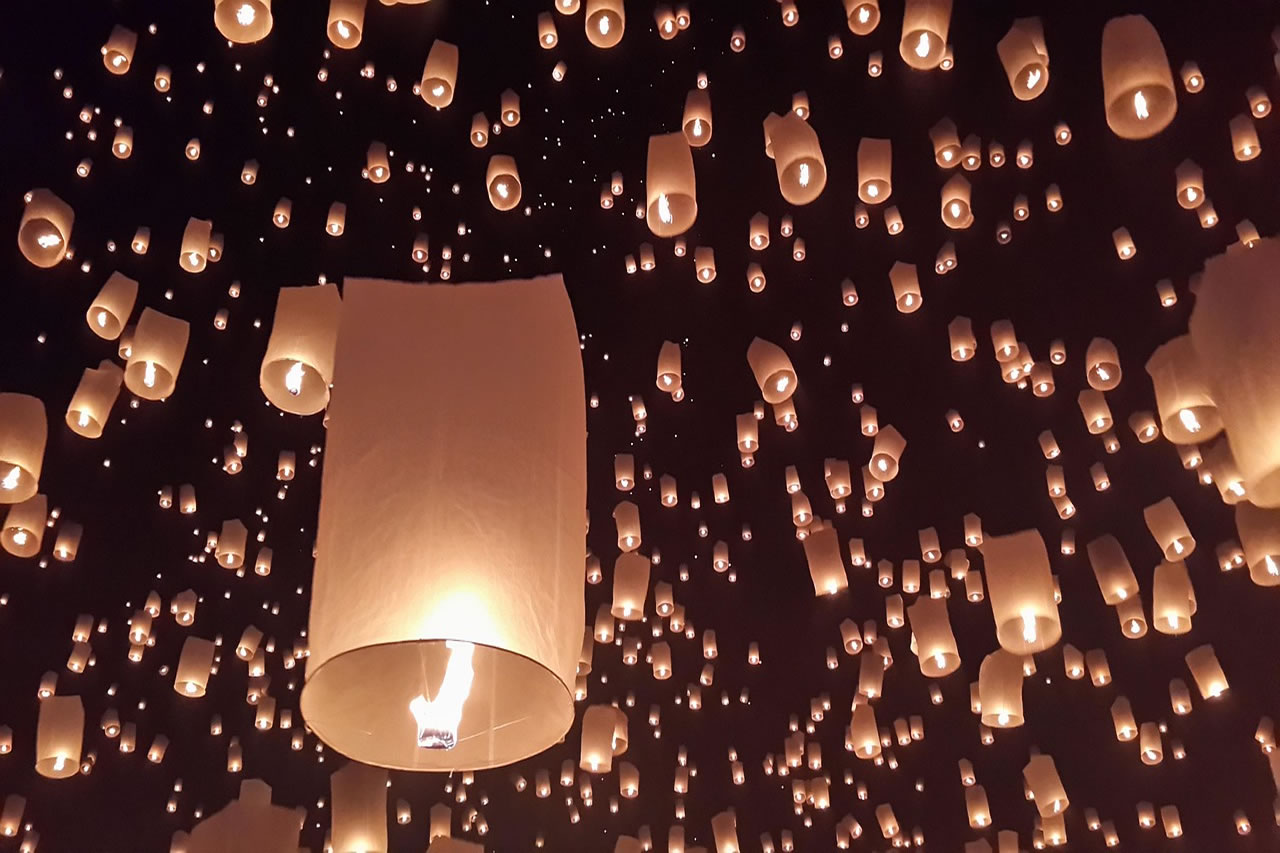Every year, when the full moon rises in the twelfth lunar month, Thailand lights up in a quiet, beautiful way. People gather by rivers, lakes, and ponds to float small, handmade krathongs—decorated with banana leaves, flowers, candles, and incense. It’s a tradition that’s been passed down for generations, and it still holds a meaningful place in Thai life today.
At its core, Loi Krathong is about showing respect to the water goddess, Phra Mae Khongkha, and symbolically letting go of things you no longer want to carry—stress, regret, or simply the weight of a long year. While it’s rooted in Thai beliefs and customs, the festival is easy for anyone to take part in.
For expats and travelers, it’s a chance to step into something truly local. Whether you’re joining a riverside event in Bangkok, floating your krathong in a small village pond, or just watching the scene unfold, it’s an experience that combines tradition, community, and a quiet kind of reflection that feels surprisingly relevant—no matter where you’re from.
The Origins and Traditional Meaning
Loi Krathong, which roughly translates to “floating a basket,” is a centuries-old tradition that blends spirituality, gratitude, and symbolism. While its exact origins are debated, it has long been embraced as a Thai way to honor water, release negativity, and start fresh.
The festival centers on paying respect to Phra Mae Khongkha, the water goddess. In a country where rivers and canals play a major role in daily life, giving thanks to the spirit of water is both symbolic and practical. Floating a krathong is also seen as a way to let go of misfortune, past mistakes, or any lingering negativity from the year.
Though rooted in Thai beliefs, the ritual is open and accessible. You don’t need to be Buddhist or know the full backstory to join in. It’s a tradition that welcomes everyone with good intentions.
How Thais Celebrate Loi Krathong
In Thailand, Loi Krathong isn’t just something people watch—it’s something they join in. The atmosphere is a mix of calm and celebration. Riversides and parks fill with soft music, the smell of street food, and the warm glow of candles and lanterns. It’s lively, but not overwhelming. And at the center of it all is the krathong.
Making a Krathong
Traditionally, krathongs are made from slices of banana tree trunk, folded banana leaves, flowers, candles, and incense. Coins are sometimes added as a small offering. Today, there’s a strong move toward using biodegradable materials, with many people crafting eco-friendly versions at home, at school, or in community workshops.
The Floating Ritual
As evening sets in and the full moon rises, people head to the water to float their krathongs. Before releasing them, many take a quiet moment to make a wish or set an intention. Some say it out loud, others keep it to themselves. Then, with a gentle push, the candlelit krathongs join dozens or even hundreds more drifting along the surface, creating a simple but memorable scene.
Festivities and Cultural Performances
Loi Krathong celebrations often include more than just floating krathongs. You’ll find traditional Thai dance shows, local parades, and beauty contests like the Noppamas Queen competition. In northern Thailand, especially in Chiang Mai, the festival overlaps with Yi Peng, where thousands of paper lanterns are released into the sky—something that adds a unique and unforgettable atmosphere.
No matter where you are—whether it’s a busy riverside in Bangkok or a quiet village—the sense of community is easy to feel. People come together to celebrate in their own way, and the overall feeling is one of respect, joy, and shared tradition.
The Festival Experience for Visitors and Expats
For visitors and expats, Loi Krathong is one of those cultural events that’s both meaningful and enjoyable. It gives you a chance to slow down, take part in something local, and still have a good time—whether that means making a wish, enjoying street food, or simply taking in the atmosphere by the water.
One of the nice things about Thai festivals is how open and welcoming they are. You’re not just watching from the sidelines—locals often invite you to take part. You might find yourself helping someone fold banana leaves into a krathong, or getting offered a grilled snack from a nearby vendor. It’s casual, friendly, and easy to join in.
You’ll see a mix of everything—maybe a monk quietly chanting in one corner of the park, while a group of teenagers nearby laugh and float neon-lit krathongs to the sound of Thai pop music. That’s part of what makes Loi Krathong unique—it blends tradition and fun in a way that feels natural.
Not everything about Loi Krathong is serious or symbolic—there’s a playful side too. Beauty pageants like the Noppamas Queen contest, named after the historical figure said to have created the first krathong, are popular in many communities. They’re colorful, lighthearted events that bring a bit of fun to the evening.
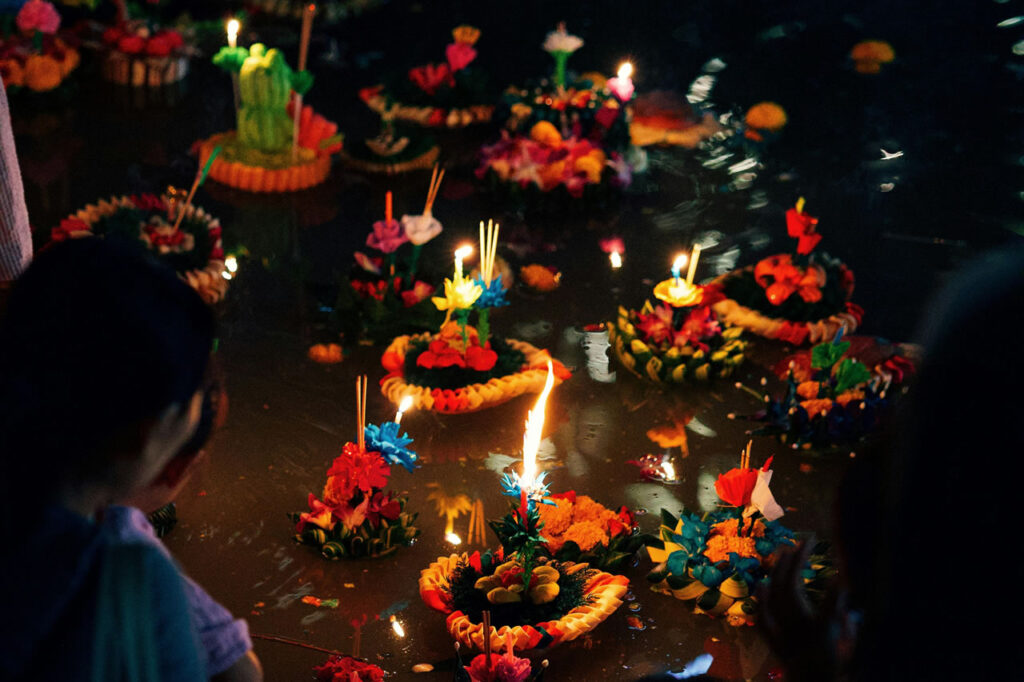
Kids (and plenty of adults) often turn it into a friendly competition—seeing whose krathong floats the longest or stays upright the best. Teenagers laugh as their krathongs drift into each other, testing the old idea that a couple’s fate can be seen in how well their offerings stay together. Some even include hair or nail clippings, as a small ritual for letting go of the past.
What makes Loi Krathong stand out is how it brings people together in a way that feels both thoughtful and relaxed. You don’t need to know all the cultural background to enjoy it. Just being there—surrounded by the soft glow of candlelight, the smell of incense, and the sound of people chatting and laughing—creates a real sense of connection.
It’s a mix of quiet moments and shared experience. And for a lot of expats, it’s one of those times when living in Thailand starts to feel more familiar—like you’re part of the rhythm of local life, not just passing through.
A Personal Note: Why Loi Krathong Matters to Me
Loi Krathong is, without a doubt, my favorite Thai festival. The idea of letting go of “old and bad things” while making space for “new and good things” is something I connect with deeply. It’s not just symbolic—it genuinely feels like a chance to reset and move forward with intention.
Each year, as I release my Krathong into the water and watch it float away, I find myself reflecting on the past twelve months—what went well, what didn’t, and what I’d like to change. It’s become a personal ritual of sorts, quiet but powerful.
More than that, it’s something I now share with my daughter. We’ve made it a tradition to celebrate Loi Krathong together, always returning to the same spot when we can. It’s become a moment of connection for us—a way to bond, reflect, and be present in a way that’s meaningful and grounding.
Modern Twists and Environmental Awareness
Like many long-standing traditions, Loi Krathong has adapted over time. Its meaning is still very much alive, but the way people celebrate has changed—partly because of modern materials, urban settings, and a growing awareness of the environmental impact.
For a long time, one of the downsides of Loi Krathong showed up the next morning—rivers and lakes filled with soggy krathongs, many made from Styrofoam or other non-biodegradable materials. Not exactly in line with a festival meant to honor nature.
That’s changed in recent years. There’s now a clear push toward using eco-friendly materials like banana leaves, coconut husks, bread, or even ice. Some communities run krathong-making contests focused on both creativity and environmental responsibility, helping raise awareness in a practical way.
At many events, you’ll see signs asking people to avoid plastic or foam, and some areas have banned those materials completely. Schools also play a role, encouraging kids to build krathongs using natural, biodegradable parts from an early age.
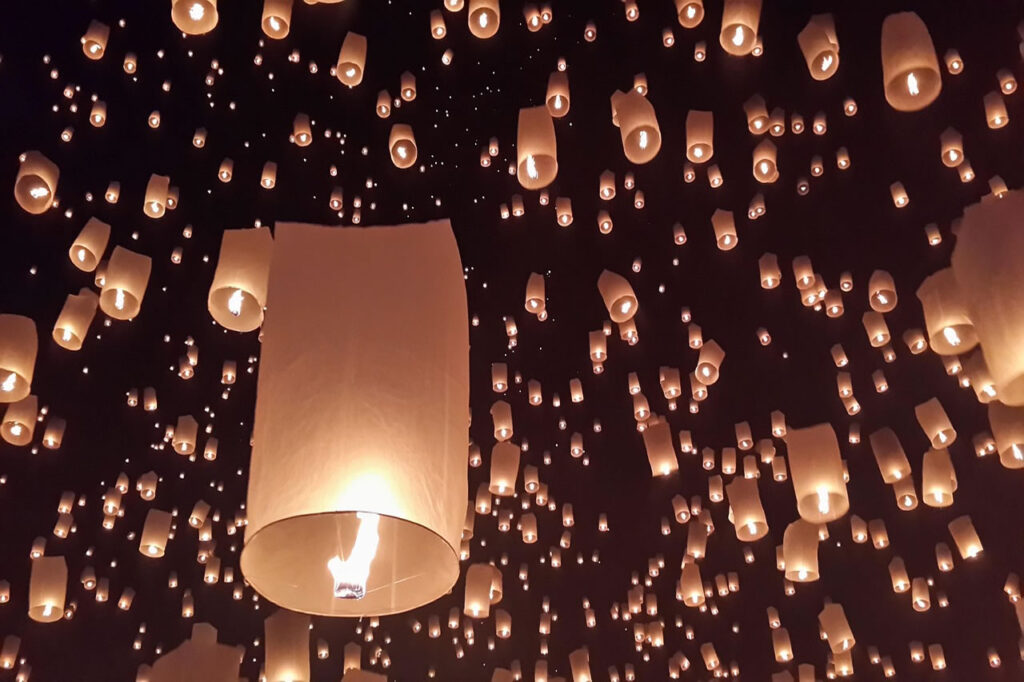
In northern Thailand, especially around Chiang Mai, Loi Krathong coincides with Yi Peng—the festival of sky lanterns. The sight of thousands of glowing lanterns rising into the night is impressive, but it also comes with a few concerns.
Sky lanterns can cause fires, interfere with air traffic, and leave behind waste in rural areas. Because of this, their use is now more controlled. Some provinces have designated areas and specific times for lantern releases, while others have banned them altogether or moved toward alternatives like drone shows or light displays.
If you’re planning to join a lantern release, it’s worth checking local guidelines. Stick to organized events and make sure any lanterns you use are safe, flame-controlled, and approved for the area.
In larger cities, access to natural waterways isn’t always easy—so people find other ways to celebrate. Shopping centers often set up decorative pools, hotels organize rooftop krathong nights, and public parks become gathering spots with lights, music, and cultural events.
Some might prefer the calm of a traditional riverside setting, but these city celebrations show how Thai culture adapts to modern spaces while keeping the spirit of the festival intact.
Embracing the Spirit of Loi Krathong as an Expat
Living in Thailand as an expat means having regular opportunities to experience traditions that go far beyond tourist brochures. And Loi Krathong is one of the most memorable. It’s a festival that invites you to take part—not just observe—and offers a glimpse into the deeper side of Thai culture.
For many expats, Loi Krathong becomes more than just a beautiful evening. It’s a chance to pause and reflect—something we often forget to do in our day-to-day routines. Whether you’ve had a tough year or simply want to mark a fresh start, the act of releasing a krathong can feel surprisingly grounding.
Even if you’re new to Thailand, you don’t need to know all the cultural details to take part. Just joining in—making a krathong, placing it on the water, and watching it float away—is a meaningful gesture in itself. Locals are usually more than happy to show you the ropes, and it’s a great way to connect across language and cultural barriers.
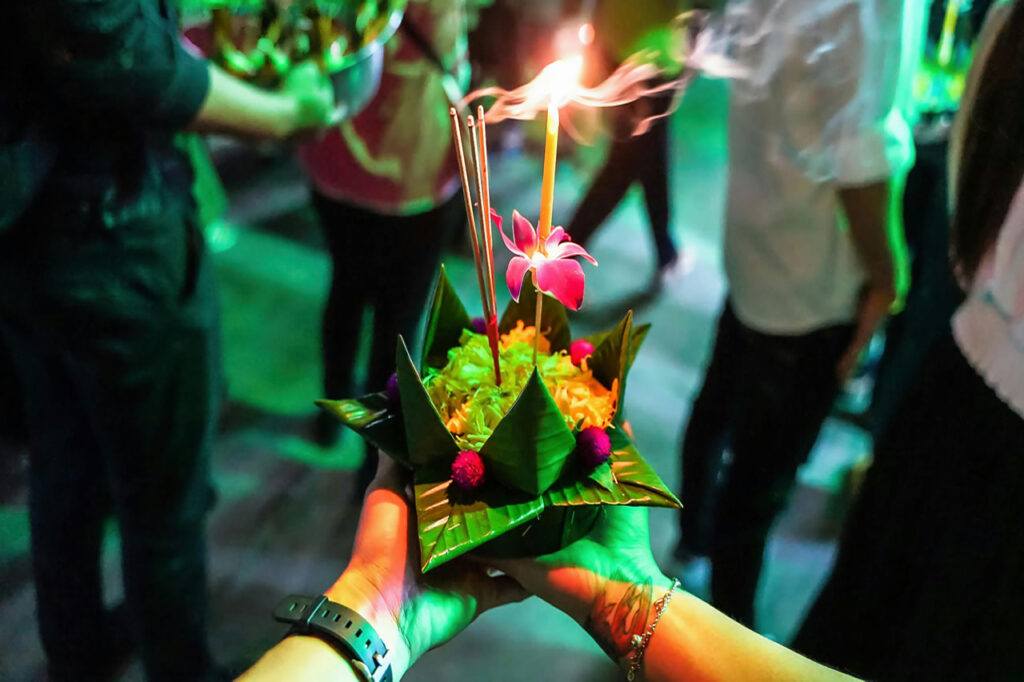
Participating in Loi Krathong is a reminder that being part of a culture doesn’t always require fluency or deep knowledge. Sometimes it just takes showing up with respect and curiosity. Whether you’re celebrating in a city park or at a village pond, the simple act of joining your Thai neighbors in this shared tradition speaks volumes.
Over time, many expats start to look forward to Loi Krathong as a kind of yearly reset. Some make it a personal tradition—going to the same spot, making a krathong with friends, or taking time to think about what they’d like to leave behind and what they hope for ahead.
Others use it as a chance to teach their children about Thai culture or take part in local events like clean-up efforts or krathong workshops. However you choose to celebrate, it’s a festival that welcomes your participation and leaves room for your own take on it.
Final Thoughts
Loi Krathong is one of those Thai festivals that’s easy to enjoy and worth understanding. It’s visually stunning, sure—but there’s also a deeper side to it that speaks to values like gratitude, respect for nature, and taking a moment to reset.
For expats and travelers, it’s a chance to do more than just watch from the sidelines. Whether you’re making a simple krathong, joining a neighborhood event, or just soaking in the atmosphere, it’s an easy way to feel a bit more connected to life in Thailand.
And while you don’t need to treat it like a life-changing moment, it might still give you a fresh perspective—or at the very least, a good memory and a few nice photos. If you’re around when it happens, take part. It’s low pressure, welcoming, and one of the more meaningful ways to engage with Thai culture in a hands-on way.
Got a Loi Krathong memory or tradition of your own? Drop it in the comments—I’d love to hear from you.
